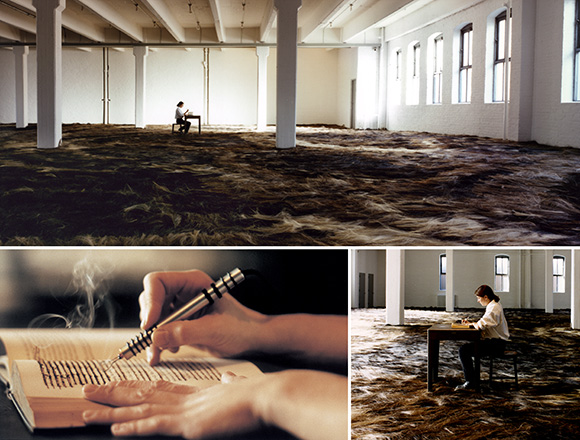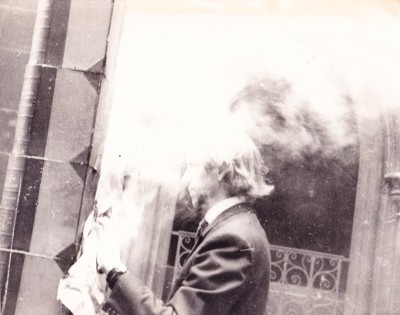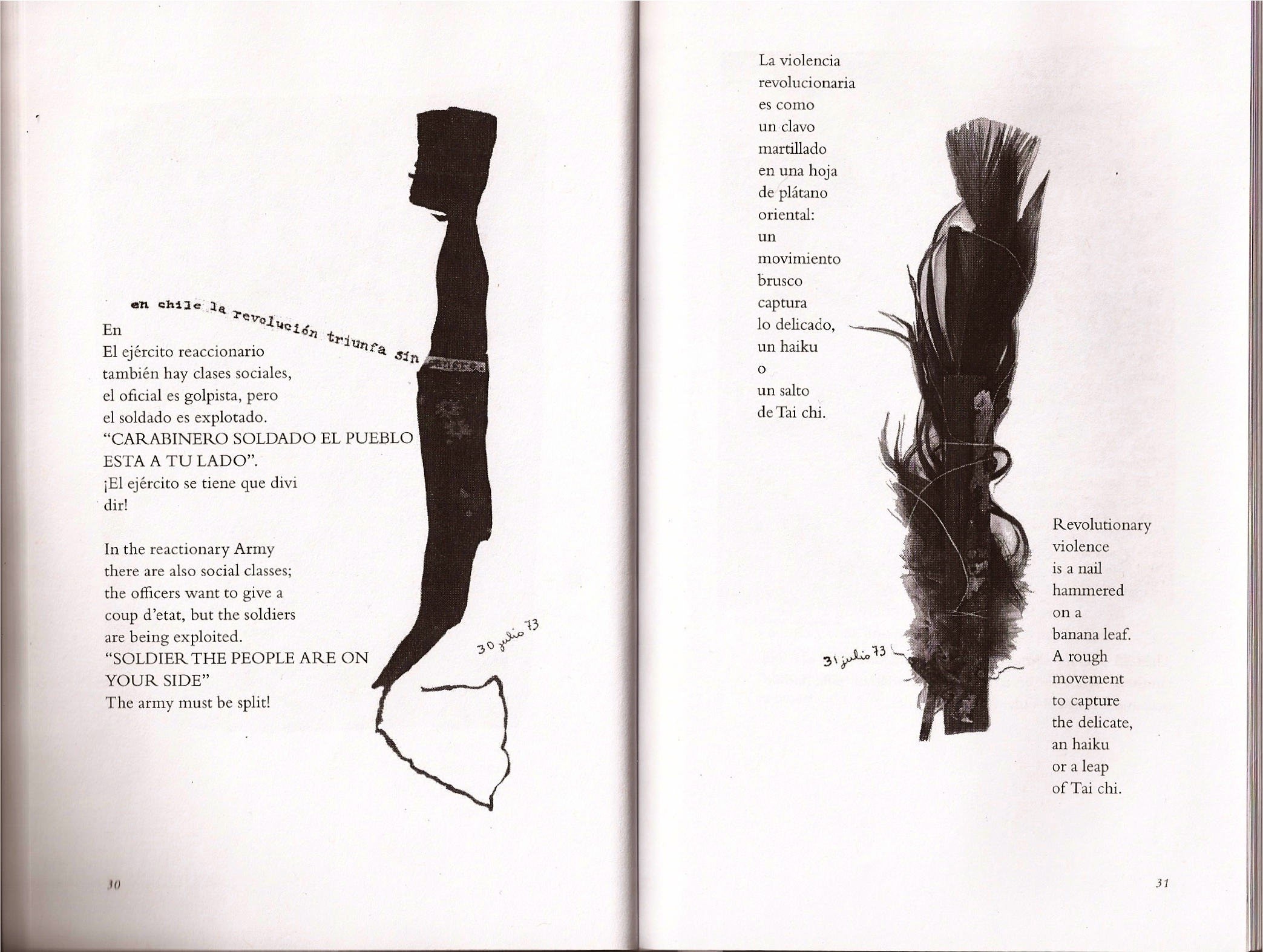Last week we discussed a numbers of writers who involve concepts of site and place in their work and we focused on the site and non-site work of the visual artist Robert Smithson.
We discussed the use of the material qualities of language in relation to a poetics of site and non-site which incorporated found material—in this case from a newspaper.
We closed the session by looking at work by Bernadette Mayer and Harryette Mullen.
This week we are thinking about performance, objects and sites…
How do actions relation to the possibilities of writing site?
Can words, language, books be considered as sites?
What relationship do objects have to the places which they come from?
How can you frame questions of site through actions and performance?
What kind of writing / objects / actions link a work to a particular place or contextual field?
How do performance works stage writing in relation to the politics of site: here and elsewhere?
Some very different examples of site and performance works that we discussed during the session included:
1. Ann Hamilton, Tropos
Ann Hamilton tropos | 1993-1994 Dia Center for the Arts New York, NY
From Ann Hamilton Studio Website:
“The Greek word “tropos” means turn, as in a physical turn of the body. The biological term “tropism” denotes the reflex reaction or response of an organism to turn toward or away from external stimuli, such as light.
Hamilton’s relatively restrained, austere treatment of this former factory space immediately focused viewers’ attention on an image/activity occurring at its center. The walls, ceiling, and pillars of the immense (approximately 5,000-square-foot) room were unaltered, but the clear windows were replaced with translucent, textured industrial panes, bathing the space in hazy light. Through this light, viewers at the entrance saw and were drawn toward a solitary figure seated at a small metal desk in the center of the space. An acrid odor of smoke and burning permeated the air. Its source became evident as viewers came closer to the seated figure. As the attendant read a book, she/he burned away the printed text line by line. The figure remained absorbed in this task, ritualistic in its deliberateness. Over the duration of the piece, the text — transformed into smoke — became absorbed as smell into the horsehair that covered the entire floor.
The horsehair, sewn in bundles, seemed to rise and fall like sea swells over a subtly graded concrete sub-floor. The ocean of hair surrounded and isolated the figure. The sounds and the difficulty of walking on this dense blanket accentuated viewers’ awareness of their presence and movement in the space. Movement through the space also activated the audio component of the installation, the low murmur of a man struggling to speak. His voice emanated from nine speakers located outside the windows at the perimeter of the room, disturbing the almost reverential silence.”
See Also: Ann Hamilton: An Inventory of Objects. New York: Gregory R. Miller & Co., 2006.
We considered how important writing was in relation to the documentation of work and some of the reasons why a an artist might choose to represent their performance work in writing.
2. John Latham, archive at Flat Time House:
John Latham with a burning Skoob Tower outside the London Law Courts, 1968.
John Latham Archive.
On the John Latham web-site, which is interestingly linked to his house which is now the site of his archive, it offers interpretation and descriptions of John Latham’s Skoob Tower Ceremonies, most of which took place between 1964 and 1968…
“The towers were around 3m high, made up of books, usually reference editions, held open at right-angles to each other with their pages interleaved, and stacked on top of a metal framework and plinth. These improvised chimneys were set alight from below, usually in conceptually loaded and public places: the Law Courts, British Museum and Senate House were all locations. The tightly-woven pages let in little air, making combustion a slow process – taking as long as a couple of hours. But when the conflagration finally came, the iconography of a flaming pillar of books was both an intellectual and emotional affront. The collective memory still held powerful images of Nazi book burnings and all they had symbolised; Truffaut’s Farenheit 451 (based on Ray Bradbury’s novel) was released in 1966. In this light, Latham’s Ceremonies could be interpreted as anti-intellectual, fascist acts of iconoclasm. Further Ceremonies took place during the Destruction in Art Symposium of 1966. DIAS, whose organising committee was led by Gustav Metzger, aligned tendencies to destruction in art during that period, to tendencies to destruction in society. As Jeff Nuttall expressed in his autobiographical account of the period, ‘Bomb Culture’ (1968), in the shadow of the bomb, violence seemed the only possible artistic response. Latham, however, was trying to express a different but no less radical agenda, one in which books are the apparatus of learnt knowledge and received opinion – a so-called ‘Mental Furniture Industry’ of which he was deeply critical. For him, books represented knowledge held fast in a congealed and unreflective form, stifling intuition. His sentiments were more in line with the writer Alexander Trocchi’s sigma project, ‘The Invisible Insurrection of a Million Minds’. A sigma gathering at Braziers Park in Oxfordshire in 1964 attended by Trocchi, RD Laing, Nuttall, Bob Cobbing and others, was the occasion of the first Skoob Tower Ceremony” John Latham Archive. (bold highlighting mine).
This piece proved to be the most controversial of the work that we discussed. It raised some really interesting questions about what was perceived by many participants as the arrogance of political gestures — particularly those made in relation to public sites.What might constitute a viable and worthwhile political writing / making practice was something that we began to address…We also discussed how the contextual meanings of art works and writings change over time.The scale of Latham’s Skoob towers were in direct contrast to the next examples….
3.
Cecilia Vicuna conceived of a piece of work in 1973 in response to the Chilean Coup
At the time of the coup in her home country, Vicuna was living in England. She was separate from the site and political situation that she wished to represent, separate from the resistance movement that she wished to be a part of. She devised a project that involved the production of a poem and object for each day which takes the form of a journal entry or diary.
She writes:
“The objects try to kill three birds with one stone:
politically, magically and aesthetically.
I conceived them as a journal. Each day is an object (a chapter) all days make a novel.
I didn’t want to make it with many words since there is hardly any time left to live”
Saborami Chain Links (2011).
In an interview she discusses the relationship of performance to site, space and audience.
See: Sound File: Upenn Performance of poetry (1:12): ![]() MP3
MP3
It is interesting to notice how she foregrounds not knowing as an important feature of the work. She highlights the way that her method of improvisation takes place as an extension of a general structure and the way that she deliberately opens the work to chance and risk.
We discussed the ephemerality of this practice and its private, journal like qualities and touched on whether it could be as effective in political terms as the pieces by Latham.
4.
http://www.lilianelijn.com/power-game-video.html
Lilliane Lijn‘s 1974 video Power Game stages a poem / performance through the rules of Chemin de Fer (Baccarat). The the initial performance of Power Game as played at the Festival for Chilean Liberation at the Royal College of Art in 1974. Staged as an altered game of Chemin de Fer, using a pack of cards Lijn both invented and designed, each card having one word printed on each side, ‘Power Game’ is a farce and an investigation of the meaning and workings of power by and on a group of invited players.
http://www.lilianelijn.com/power-game-
restaged at the ICA in 2009
http://www.lilianelijn.com/power-game-ica-trailer.html
Together we watched the trailer for the remake of Power Game (2009) which intersplices footage from the original staging in 1973 with the remake.
The participants then considered which aspects of the examples held interest for their own practice and ambitions as writers.
Exercises:
1.
Pick two objects that have come from the site (perhaps feathers, stones, rubbish or other found materials….). Take them away from their original context / site. Try to write them back to their original site in whatever way seems appropriate to you…
Devise a way to present the texts and images that you make in relation to one another.
Consider the site of presentation of the finished work?
2.
Alter a pack of playing cards by adding words and phrases related to your site.
Using your altered pack of playing cards devise (an action or series of reading strategies) which involves the use of chance, risk and play…
(experiment with single / multiple participants and different types of words and phrases i.e. invitations, facts, verbs, adjectives…).


